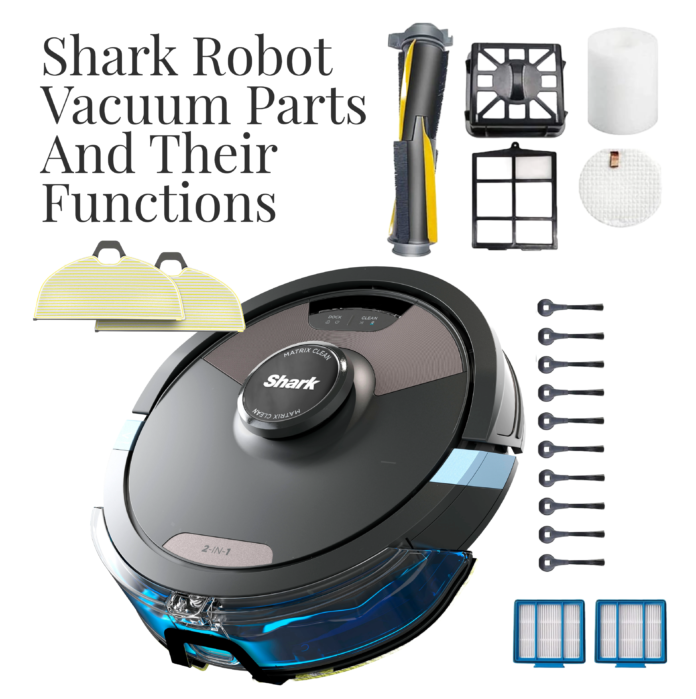Shark robot vacuums have revolutionized home cleaning, blending advanced technology with user-friendly design. These autonomous cleaners are celebrated for their efficiency in keeping homes dust-free and their ability to navigate complex environments. This article aims to Shark Robot Vacuum Parts And Their Functions demystify the various components that make up Shark robot vacuums, offering insights into their functions and the role they play in maintaining a clean home. Understanding these elements not only enhances user experience but also aids in troubleshooting and maintaining the vacuum’s longevity.
Table of Contents
The Core Components
1. Main Body
The main body, crafted from robust materials, is the framework that houses the vacuum’s integral parts. It’s engineered to withstand minor impacts and the wear and tear of regular use. Inside, the layout is meticulously designed to accommodate the motor, dustbin, and electronic components in a compact form.
Also read: How To Reset Shark Robot Vacuum?
2. Motor
This is the powerhouse of the vacuum. Shark robot vacuums often employ brushless motors known for their efficiency and longevity. The motor’s role extends beyond just suction; it’s also pivotal in driving the wheels and rotating the brushes. Some models feature variable speed motors that adjust the suction power based on sensor feedback, optimizing battery usage and cleaning efficiency.
3. Batteries
The choice of batteries is crucial. Shark vacuums typically use rechargeable lithium-ion batteries for their balance of weight, capacity, and charge retention. These batteries determine the vacuum’s run time and influence the overall cleaning time. Understanding battery care can significantly impact the vacuum’s performance over its lifespan.
4. Sensors
The array of sensors in a Shark robot vacuum is akin to a nervous system. Proximity sensors prevent collisions with furniture and walls, cliff sensors avoid falls, and dirt sensors adjust cleaning intensity. Some models even feature mapping sensors to create efficient cleaning paths and remember room layouts.
5. Brushes
The main brush, often a combination of bristles and rubber fins, is designed to agitate and lift dirt from carpets and hard floors. Side brushes extend the vacuum’s reach, sweeping debris from edges and corners into the suction path. The material and design of these brushes are tailored to balance effective cleaning with gentle contact on various surfaces.
Also read: All About Shark Robot Vacuum
Additional Components Features
1. Dustbin
The dustbin’s capacity and design are critical. A larger bin means less frequent emptying, which is convenient for users. The ease of removal and cleaning of the dustbin directly affects the user experience. Some models feature a self-emptying function, further reducing manual intervention.
2. Filters
Filters in Shark robot vacuums play a vital role in air quality. HEPA filters, capable of trapping 99.97% of dust and allergens, are common in many models. Foam and felt filters provide additional layers of filtration. Regular cleaning of these filters is essential to maintain suction efficiency and indoor air quality.
Also read: Top Solutions If Shark Robot Vacuum Not Charging
3. Wheels
The design of the wheels impacts the vacuum’s ability to transition between different floor types. Large, treaded wheels help navigate over thresholds and carpets, while swivel wheels aid in maneuverability and precise navigation.
4. Control Panel/Interface
Modern Shark robot vacuums often come with intuitive control panels, remote controls, and even Wi-Fi connectivity for app-based control. This flexibility allows users to customize cleaning schedules, monitor the vacuum’s status, and control it remotely.
Also read: PROS AND CONS OF USING A ROBOT VACUUM
Maintenance and Replacement
Regular maintenance is key to the Shark robot vacuum’s performance. This includes cleaning the brushes, emptying the dustbin, and replacing filters and batteries as needed. Users should also check for software updates to ensure the vacuum operates with the latest features and improvements. Knowing when to replace parts like brushes and batteries is crucial; worn brushes can reduce cleaning efficiency, and aging batteries may decrease run time. Regularly inspecting and cleaning the sensors can also prevent navigation issues.
Also read: Things To Consider Before Buying A Robot Vacuum
Conclusion
Fully understanding the parts of your Shark Robot Vacuum Parts And Their Functions is pivotal for maximizing its performance and lifespan. Regular maintenance not only ensures efficient cleaning but also contributes to the longevity of the vacuum. While this article provides a comprehensive overview, always refer to the specific model’s user manual for detailed care instructions and troubleshooting tips. With proper care, your Shark robot vacuum can be a reliable and efficient cleaning companion for years to come.

